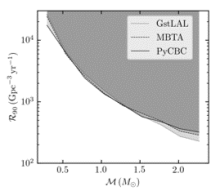
Abstract
We report on a search for compact binary coalescences where at least one binary component has a mass between 0.2 M⊙ and 1.0 M⊙ in Advanced LIGO and Advanced Virgo data collected between 1 April 2019 1500 UTC and 1 October 2019 1500 UTC. We extend previous analyses in two main ways: we include data from the Virgo detector and we allow for more unequal mass systems, with mass ratio q≥0.1. We do not report any gravitational-wave candidates. The most significant trigger has a false alarm rate of 0.14 yr−1. This implies an upper limit on the merger rate of subsolar binaries in the range [220−24200]Gpc−3yr−1, depending on the chirp mass of the binary. We use this upper limit to derive astrophysical constraints on two phenomenological models that could produce subsolar-mass compact objects. One is an isotropic distribution of equal-mass primordial black holes. Using this model, we find that the fraction of dark matter in primordial black holes is fPBH≡ΩPBH/ΩDM≲6%. The other is a dissipative dark matter model, in which fermionic dark matter can collapse and form black holes. The upper limit on the fraction of dark matter black holes depends on the minimum mass of the black holes that can be formed: the most constraining result is obtained at Mmin=1M⊙, where fDBH≡ΩPBH/ΩDM≲0.003%. These are the tightest limits on spinning subsolar-mass binaries to date.